Topical Finasteride for Hair Loss
Hair loss is a common condition and can cause incredible stress and anxiety in both men and women. According to the American Hair Loss Association, over 65% of men experience hair loss at some point in their lives, and about 40% of people who report hair loss are women. Causes and treatment for hair loss have been popular topics in healthcare discussions for decades. There are many treatment options available, ranging from over-the-counter (OTC) topicals and in-office procedures like Platelet Rich Plasma injections (PRP) to surgical options like hair transplants. It can be overwhelming to determine which treatments are safe and effective for your specific hair loss. If you are experiencing hair loss, hair thinning, or balding, Dr. Michele Green is here to help.
Dr. Green is an expert in hair loss and has been treating hair loss in men and women at her discreet Upper East Side dermatology office for over 25 years. As a leader in hair loss treatments and Platelet Rich Plasma (PRP) for androgenetic alopecia, Dr. Green keeps abreast of updated medical and cosmetic hair loss treatments and utilizes modern technology to treat different types of hair loss based on her evaluation and assessment. Dr. Green also has her own line of hair serums specially formulated to cater to each individual. Dr. Green will perform a full assessment of your scalp, the quality of your hair, and your medical history to determine the cause for your hair loss and recommend the best combination of treatments for hair regrowth and delaying androgenetic alopecia.
Topical Finasteride
Finasteride is an oral medication that was developed in the 1970s and was approved by the Food and Drug Administration for treatment of benign prostatic hyperplasia (BPH) or enlarged prostate in 1992, and for treatment of male pattern hair loss (androgenetic alopecia) in 1998. Finasteride works by inhibiting the activity of the enzyme 5-alpha-reductase, and it falls under the medication category of 5-alpha reductase inhibitors. 5-alpha-reductase is responsible for the conversion of testosterone to dihydrotestosterone (DHT), which is the androgen, or male sex hormone, responsible for causing BPH in men and hair loss in men and women. Dihydrotestosterone is advantageous in earlier years during puberty in the development of sexual organs and body hair growth. However, DHT can lead to hair loss in later years of adulthood in both men and women. DHT causes the size of hair follicles to shrink, leading to thinner and shorter hair formation that may or may not penetrate the scalp. Studies have shown increased DHT production and increased levels of 5-alpha-reductase and androgen receptors in patients (both men and women) with androgenetic alopecia. Therefore, finasteride decreases DHT levels to encourage hair restoration.
Currently, the Food and Drug Administration (FDA) has approved topical minoxidil and oral finasteride for the treatment of hair loss in men. Oral finasteride is also known by its brand name Propecia® for hair loss treatment and Proscar® for BPH treatment. However, recent clinical studies using topical treatment of finasteride (in gel and solution form) decreased the overall rate of hair loss and increased total and terminal hair counts. Terminal hair refers to the thick, long, pigmented hair that grows on the scalp, axilla, groin, and beard. A major benefit of topical finasteride is that it is a localized treatment, as opposed to oral finasteride which works systemically to block the conversion of testosterone to DHT. Studies have shown a significant decrease in systemic side effects and sexual dysfunction with topical finasteride use that have been previously reported with oral finasteride.
Is topical finasteride as effective as oral?
Topical application of finasteride has shown to be just as effective, if not more effective, as taking oral finasteride, also known for its brand name Propecia. Finasteride works by inhibiting the activity of 5-alpha-reductase, which converts testosterone to dihydrotestosterone (DHT). A clinical study comparing oral finasteride to topical finasteride in 24 men with androgenetic alopecia showed decreased DHT levels by 68-75% with daily application of topical finasteride for 7 days, and by 62-72% with oral finasteride tablets for 7 days. Furthermore, topical finasteride showed 10-15 times less absorption than the oral tablet that is absorbed systemically. This suggests that topical finasteride may have less possible systemic side effects that have previously been reported with oral finasteride. Two other clinical studies have shown similar therapeutic effects with topical or oral finasteride, such as a decrease in the rate of hair loss, a significant increase in total and terminal hair counts, and positive hair growth assessment compared to baseline.
Another study compared the effects of oral finasteride and topical finasteride using two groups of men: the first group used 1% finasteride gel topically and took placebo tablets, and the second group used a gel base topically as a placebo and took finasteride 1 mg orally. Researchers observed an increase in terminal hair count in both groups, and there were no significant differences in the therapeutic effects between the two groups.
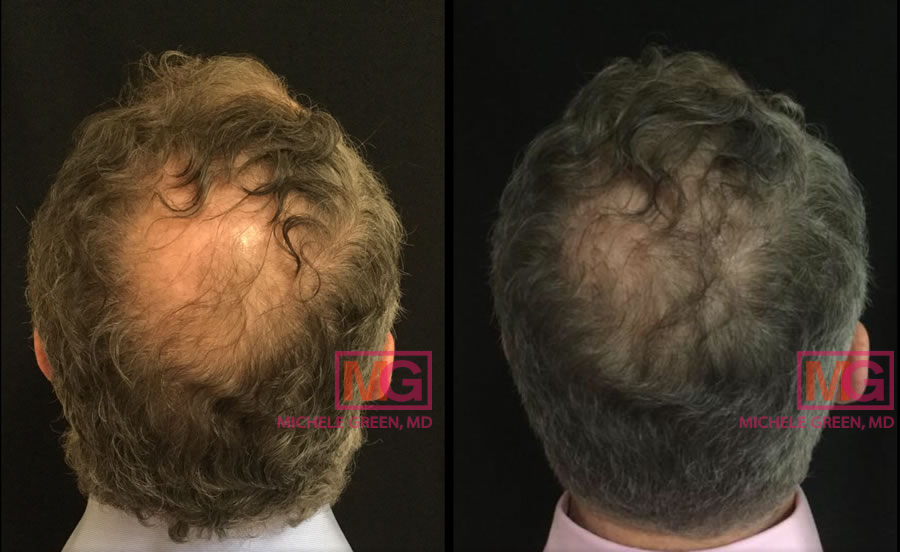
4 PRP treatments – 9 months before and after
Does topical finasteride have side effects?
Many patients are hesitant on starting oral finasteride for hair loss treatment due to its reported rare systemic and sexual side effects, and seek alternatives for hair restoration and regrowth. Topical finasteride has proven to decrease DHT levels to improve hair loss and stimulate hair follicles. Topical finasteride, therefore, has the potential to cause similar side effects as oral finasteride, which also decreases DHT levels. However, topical finasteride decreases scalp DHT levels at a localized region and does not impact serum DHT levels in the body as much as oral finasteride.
Topical finasteride has a significantly less chance of causing systemic side effects and sexual side effects because it is not broken down and dispersed throughout the body through the blood vessels like oral finasteride. It is important to note that although topical finasteride is applied on a localized area, it is still absorbed through the skin and blood vessels. However, the absorption of topical finasteride is at a much lower concentration than if finasteride is taken orally. Mild side effects reported with the usage of topical finasteride include erythema, a localized superficial redness of the skin due to irritation, and contact dermatitis. More rare side effects reported in some topical finasteride studies include presyncope, conjunctivitis, headache, and oropharyngeal pain.
Oral finasteride (generic for Propecia®) has been approved by the FDA for use in hair loss treatments in men since 1997. Oral finasteride is generally well-tolerated, but it has reported very rare sexual side effects such as decreased libido (sexual drive), erectile dysfunction, decreased ejaculation volume, and gynecomastia, which is an enlargement of breast tissue in men or boys. These sexual side effects occur because finasteride, when taken orally, is broken down and transported through the blood vessels to the rest of your body. Finasteride may interact with the DHT present in the testicles and prostate, decreasing serum DHT levels and triggering sexual side effects in men. Sexual dysfunction was reported in only 4% of men who take oral finasteride. These side effects are the result of the decreased DHT levels. It is important to note that while oral finasteride can affect sexual function, it has not been linked to infertility in men.
Adverse reactions from topical finasteride application are rare. In fact, most people who use topical finasteride report no side effects at all. If you are experiencing side effects, it usually lasts only a few days as your body becomes accustomed to the medication. If the side effects persist longer than 2 weeks, follow-up with your dermatologist or general practitioner. Finasteride is also teratogenic, which means it can disrupt embryo or fetus development and cause birth defects. Therefore, finasteride should not be taken orally or used topically if you are pregnant. For premenopausal women, it is best to use a reliable form of birth control while taking or using finasteride.
If you are considering topical finasteride or oral finasteride as treatment options for hair loss, contact Dr. Michele Green in NYC to discuss if finasteride is the best treatment option for you. Dr. Green has been an international leader in treating hair loss in men and women in her NYC dermatology office for over 25 years. She examines your full medical history and completes a full assessment to create the best combination of treatments for your specific hair loss.
What is minoxidil?
Minoxidil was originally created as an oral medication to treat hypertension in the 1970s. Minoxidil is considered a vasodilator, and it works to lower blood pressure by relaxing the blood vessels for easier passage of blood. While treating for hypertension, physicians observed hair regrowth and hypertrichosis, or excessive hair growth. This led to the development of topical minoxidil for the treatment of androgenetic alopecia in male patients. Topical minoxidil was approved by the FDA for the treatment of hair loss in men in 1988. The most common over-the-counter topical minoxidil is Rogaine®, which comes in a variety of strengths ranging from 2% to 5%. Minoxidil solution is made of inactive ingredients such as water, propylene glycol, and ethanol. The purpose of these inactive ingredients is to increase the solubility of the minoxidil and serve as a vehicle for efficient delivery of minoxidil to the hair follicles. Over-the-counter minoxidil today comes in two forms: topical solution and topical foam. The foam version is free of propylene glycol, which was created because the solution frequently caused local irritation on the scalp. A clinical study in 2019 has shown increased penetration of minoxidil and decreased scalp irritation in the foam formulation than in the topical formulation.
The exact molecular mechanism of how minoxidil works for hair loss is still unknown. Research has shown when minoxidil is applied on the scalp, a scalp enzyme called sulfotransferase converts the minoxidil into minoxidil sulfate, which is a salt. Minoxidil shortens the telogen or shedding phase of the hair, allowing it to proceed to the anagen or growing phase. This results in the stimulation of your hair follicles to grow new, healthy hair.
Finasteride is usually prescribed in combination with minoxidil use. Additionally, recent studies have shown efficacy in hair growth with a topical finasteride and minoxidil combination. Research suggests that minoxidil increases the absorption of topical finasteride to deliver the best results.
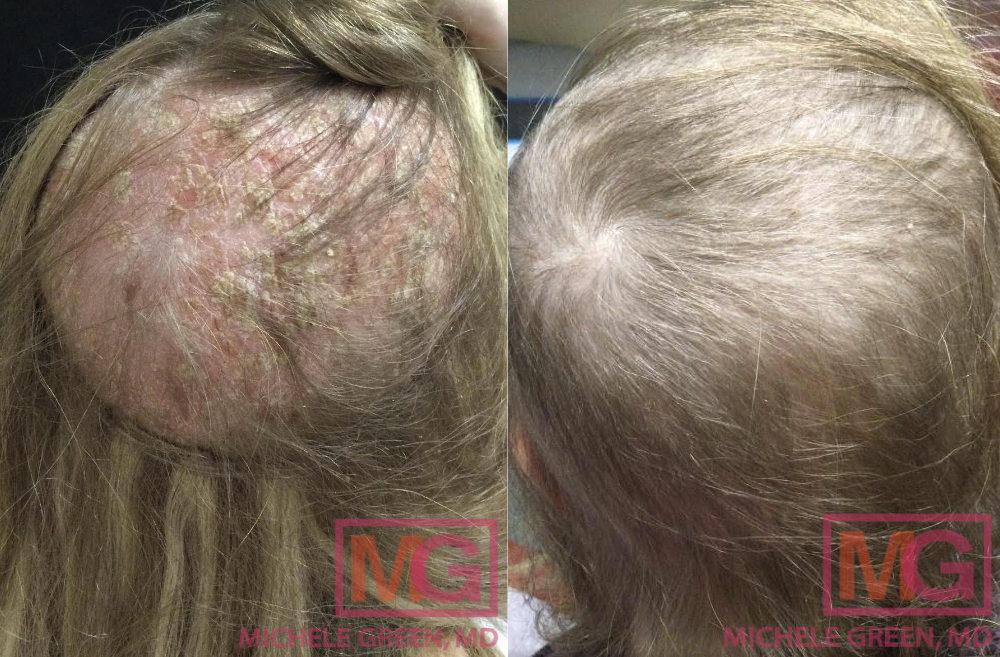
Female patient – 2 sessions of PRP
Androgenetic Alopecia
Androgenetic alopecia (AGA) is the most common type of hair loss, affecting more than 50 million men and 30 million women in the United States. AGA is also known as male pattern baldness in men and female pattern baldness in women. The pattern of hair loss in men is characterized by an “M” shape. The hair loss usually begins at the top of the temples and over time, the hairline gradually recedes to form the “M” shape. The hair also thins out at the crown or the top of the head and can lead to partial or total baldness. In women, the hair loss is diffused throughout the crown and the top of the head and is characterized by a widening center part. Hair loss in women rarely progresses to total or partial baldness as it may in men.
Androgenetic alopecia is a disorder with a genetic predisposition that leads to an excessive response to androgens. Those with a family history of hair loss are more likely to experience signs of male or female pattern baldness. Dihydrotestosterone (DHT) is a natural byproduct of the breakdown of testosterone in our bodies. It is an androgen, or male sex hormone, responsible for secondary sex characteristics (like body and facial hair growth). DHT is beneficial in earlier years during puberty for the development of sexual organs, but it can cause adverse effects later on, like hair loss. DHT binds to androgen receptors located in the hair follicle, which shrinks and weakens the hair follicle. The activation of androgen receptors miniaturizes the hair follicle and shortens the growth phase of the natural hair growth cycle, leading to thinner, shorter hairs that may or may not penetrate through the epidermis. DHT is the hormone responsible for hair loss in both men and women.
Is topical finasteride effective?
There are many published studies currently that have proven topical finasteride to be effective in treating androgenetic alopecia. A systemic overview in 2018 of seven topical finasteride studies found an overall decrease in the rate of hair loss, an increase in terminal hair count, and positive hair growth assessment. The studies also found a decrease in scalp DHT levels and concluded “safe and promising” results for hair loss treatment. Another review of 33 peer-reviewed articles in 2020 for topical finasteride found similar conclusions, also emphasizing a positive safety profile. A clinical study conducted in 2015 investigated the effects of using a topical 5% minoxidil with 0.1% finasteride solution after using 5% minoxidil solution and oral finasteride for two years. 84% of participants reported maintenance of good hair density with the continuation of treatment using the minoxidil-finasteride solution. Even patients who prematurely discontinued the use of oral finasteride and began the topical minoxidil-finasteride solution have reported improvement in hair density after starting the topical treatment. Research in its safety and efficacy is still underway for FDA approval in prescription use.
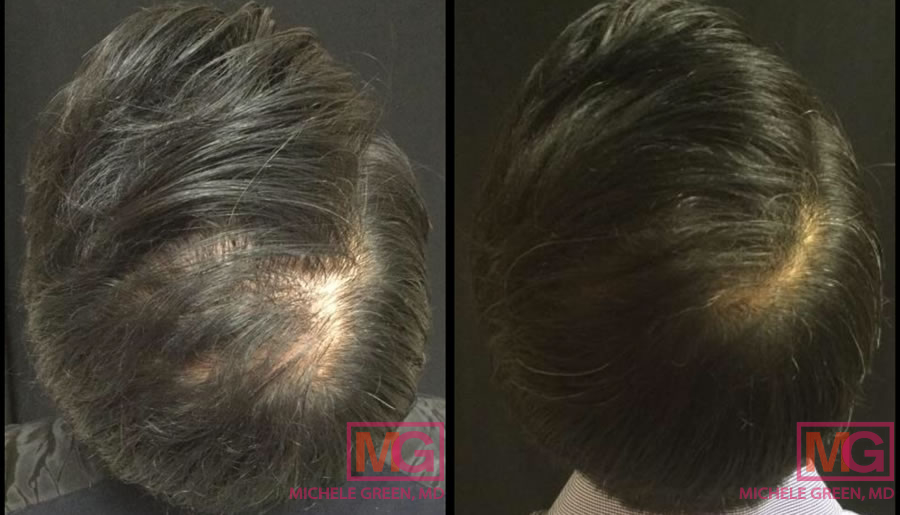
15 months after PRP
How long does it take for topical finasteride to work?
Finasteride, when applied topically, works to block the conversion of testosterone to DHT on the scalp almost instantly. However, it takes at least four months to see an improvement in hair growth because your hair takes time to grow. The hair growth cycle consists of four stages. Clinical studies have shown evidence of noticeable new hair growth three to six months after starting the daily use of topical finasteride. Most participants reported significant, visible improvement in six months.
The hairs on our scalp and body undergo a growth cycle consisting of four phases. Your hair grows, on average, one inch every two months. There are two main structures in the hair that are pertinent to hair growth. First is the hair follicle, present in the dermis and epidermis, which produces new hairs via complex processes that create new cells. The second is the hair shaft, which is the part of the hair that grows out of the skin and is not bound to the hair follicle. The hair shaft grows from the hair bulb, which is an area in the hair follicle that makes new keratinized cells that make up the hair shaft.
The first phase of the hair growth cycle is the anagen phase, also known as the growth phase. The anagen phase can last three to five years for the hair on the scalp, and the length of the anagen phase is unique to the specific body part (i.e. eyebrow hairs and pubic hairs). During this phase, the hair follicle pushes out new hairs that continue to grow until they are cut or reach the end of their lifespan and shed. About 90% of the hairs on the scalp are in the anagen phase at any given moment.
The second phase is the catagen phase, which is a transition phase that begins when the anagen phase terminates. During this phase, the size of the hair follicle decreases and the rate of hair growth decreases. The hair separates from the bottom of the hair follicle but remains attached to the scalp until the growth is finished. The catagen phase lasts about 10 days. The third phase is the telogen phase, also known as the resting phase. Think of it as your old hair resting as new hairs start to form. New hairs start to develop in the hair follicle as the hair follicle has just released the old hair. The fourth phase is the exogen phase, which is a part of the resting phase. The old hair sheds as new hairs grow. Losing 50 to 100 hairs is considered normal daily shedding, and can be done with the assistance of washing and brushing.
How to apply topical finasteride
Topical finasteride, available in combination with topical minoxidil in a solution form, comes in a dropper bottle. Apply up to 1 mL of the solution directly to the scalp in the affected areas showing a lack of hair growth. It is not necessary to rub the product into the scalp, but maneuvering it with your fingers to spread it on the affected areas will not hinder the efficacy of the topical finasteride. It is recommended to apply topical finasteride twice a day, once in the morning and once at night. However, patients have complained of their scalp feeling greasy throughout the day when topical finasteride is applied in the morning. In this case, it is okay to apply the solution once a day at nighttime. Always be sure to consult with Dr. Green if you are unsure of the method or frequency of use if you are using topical finasteride and/or minoxidil. MGSKINLABs also has Hair Revitalizing Serum for Men and Hair Revitalizing Serum for Women available online.
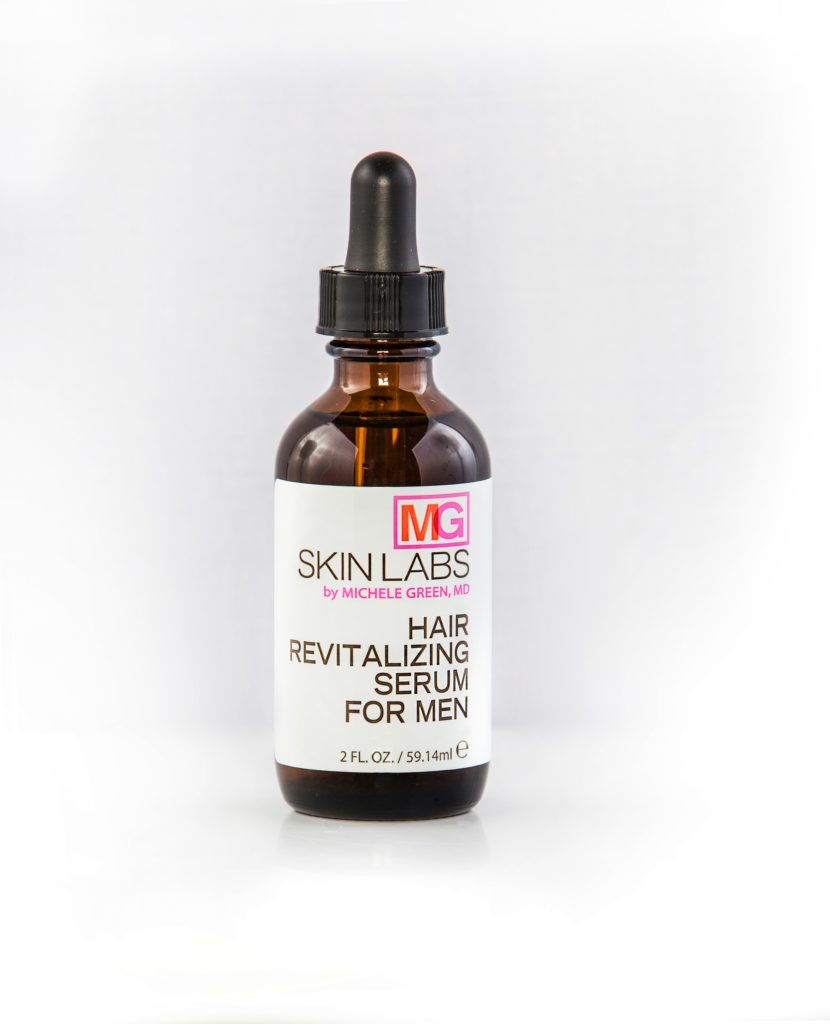
Does topical finasteride go systemic?
No, topical finasteride does not work systemically in our bodies. A benefit of topical finasteride is that it is a localized treatment that decreases DHT levels on the scalp but does not have a significant effect on serum DHT levels throughout the body. Finasteride, when taken orally, is absorbed and diffused through the entire body, which means it can also interact with DHT that is naturally present in the testicles and prostate. This can lead to rare sexual side effects like erectile dysfunction, decreased libido, and decreased ejaculation volume. Finasteride, when applied topically, does get absorbed through the skin circulates in our bodies through the blood vessels. However, the concentration of finasteride in the topical formulation is significantly less than in the oral formulation. Research has also shown that the rate of absorption in topical finasteride is significantly less than the rate of absorption in oral finasteride. Clinical studies of topical finasteride have not reported systemic side effects or sexual dysfunction in both treatment and placebo groups.
Can I get finasteride over the counter?
Topical finasteride is currently not available over the counter because it is not yet FDA approved for treating hair loss. Research in the safety and effectiveness of topical finasteride is still in progress. Oral finasteride has been approved by the FDA for hair loss treatment since 1997. Oral finasteride must be prescribed by a physician due to the potential negative side effects like fatty liver disease and kidney dysfunction. It is best to consult with a board-certified dermatologist and hair loss expert like Dr. Michele Green to discuss the best plan for your hair loss based on your medical history and physical assessment.
Where to buy topical finasteride
Currently, finasteride is not approved by the FDA for topical use in hair loss treatment. Therefore, it is not yet available for over-the-counter purchases at local pharmacies. First, consult with a dermatologist like Dr. Green to determine if topical finasteride is the right treatment option for you. She will complete a full assessment of your scalp and hair and talk about your history and experience with hair loss. Then, Dr. Green will construct a combination of treatments to give your hair the best chance for regrowth. Topical finasteride must be prescribed by a physician and made at a special compounding pharmacy. Contact Dr. Michele Green, a board-certified dermatologist and expert in hair loss, to see if topical finasteride treatment would be beneficial for reversing or preventing future hair loss.
How to make topical finasteride
There are DIY instructions on the internet on how to make topical finasteride at home using finasteride tablets. This process involves crushing up finasteride tablets and mixing them with a minoxidil solution to produce the solution used in some clinical studies. However, making a topical finasteride solution at home is not recommended because this method has not been studied to be effective or safe. Finasteride tablets also contain inactive ingredients that prevent the tablets from breaking down in the container. Furthermore, there are emulsifiers, lactose, and other ingredients in finasteride tablets that help them break down in the digestive system. Because the tablets were not designed for topical application, they may cause irritation on the scalp. Additionally, the mechanism of inhibiting DHT conversion systemically is different from DHT conversion locally on the scalp. There is no scientific evidence that the dosage of oral finasteride is also effective in topical finasteride.
Topical finasteride can be compounded at a specialty pharmacy through orders made by a physician. It is highly recommended to consult with a board-certified dermatologist like Dr. Green to discuss the best treatment options for your specific type of hair loss.
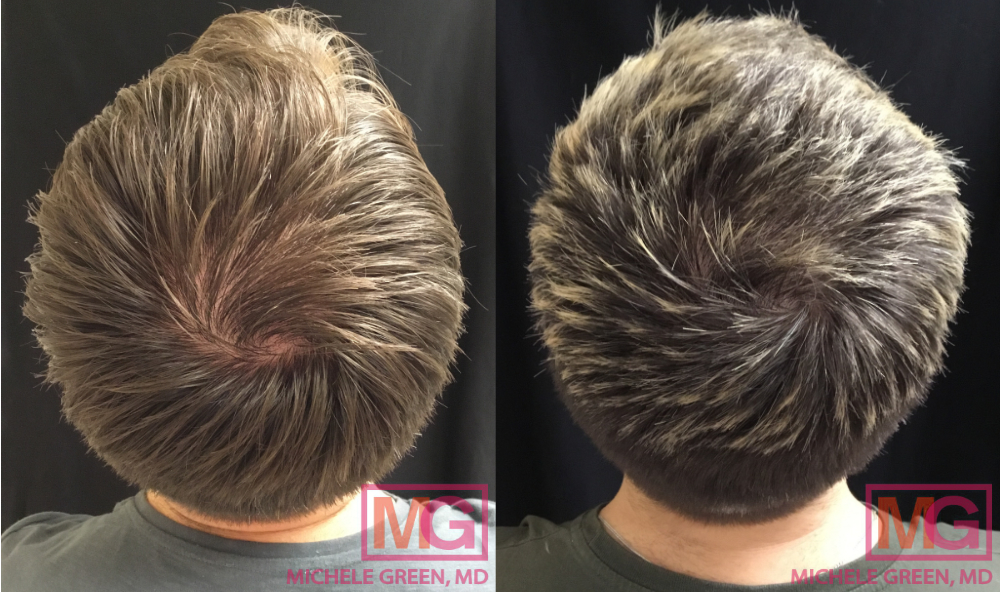
6 months before and after PRP treatment
Is finasteride FDA approved?
Currently, topical finasteride is not yet approved by the Food and Drug Administration for hair loss treatment and is awaiting clinical trials for FDA approval. Oral finasteride (generic for Propecia) has been approved by the FDA for hair loss treatment in men since 1997, and it can be obtained through prescription only. Oral finasteride is not FDA-approved for hair loss treatment in women, but it can be prescribed by a physician for off-label use.
Is finasteride prescription only?
Oral finasteride, generic for Propecia, is available by prescription only. Topical finasteride, usually in combination with minoxidil in the form of a solution, is also available by prescription only. Consult with Dr. Michele Green, a board-certified dermatologist with over 25 years of experience in hair loss, to discuss if finasteride is a viable treatment option for your hair loss.
Is topical finasteride safe?
Yes, topical finasteride is generally safe to use on your scalp for hair loss treatment. Per the Food and Drug Administration (FDA), finasteride does not have interactions with other drugs. Therefore, finasteride is safe for oral and topical use in combination with other medications. Current research has reported little to no side effects associated with topical finasteride application. Mild side effects reported with the usage of topical finasteride include erythema, a localized superficial redness of the skin due to irritation, and contact dermatitis. If you have a history of sensitivity with topical medications, consult with Dr. Green to see if topical finasteride is recommended for you. If you have a known allergy or sensitivity to finasteride or minoxidil, avoid using finasteride topical treatment.
It is important to note that finasteride is considered a teratogen, which means it can hinder the development of an embryo or a fetus. Therefore, finasteride (oral or topical) is not recommended for those who are pregnant. If you are pregnant or suspect pregnancy, consult with your physician to revise your treatment plan.
If you are considering topical finasteride for treating your hair loss but have reservations about safety and possible side effects, consult with Dr. Michele Green to see if finasteride is the right treatment option for you.
Can you take oral and topical finasteride?
It is possible to take oral finasteride in combination with topical application of finasteride solution to treat androgenetic alopecia. Both topical and oral finasteride must be prescribed by a physician in the United States. There are certain medical conditions like liver disease or prostate cancer that may cause adverse side effects with finasteride. Consult with a board-certified dermatologist Dr. Green to see if oral and/or topical finasteride is the right treatment option for your specific hair loss and medical history.
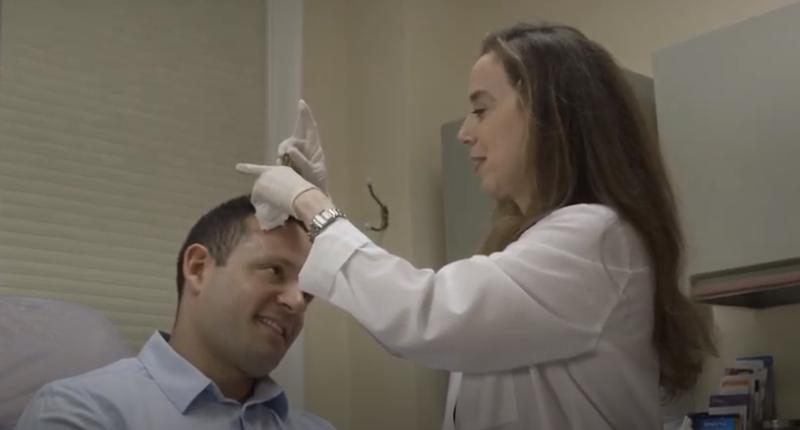
Dutasteride
Dutasteride is a notable medication that has recently become a popular treatment for hair loss. Dutasteride is a prescription medication commonly known for its brand name Avodart, and it shares many similarities to finasteride. Like finasteride, dutasteride is also considered a 5-alpha-reductase inhibitor. Dutasteride prevents the conversion of testosterone to dihydrotestosterone (DHT), which is the androgen responsible for causing hair loss in men and women. Dutasteride also has a history of treating benign prostatic hyperplasia because DHT is also responsible for prostate enlargement.
Dutasteride was approved by the FDA in 2001 to treat BPH but has yet to be FDA approved for hair loss. The main difference between finasteride and dutasteride is that finasteride is selective for 5AR type II while dutasteride inhibits both types I and II. Dutasteride has a longer half-life of 5 weeks compared to finasteride with a half-life of 5-6 hours. Dutasteride was also found to be three times more potent than finasteride in 5AR type II inhibition and one hundred times more potent in 5AR type I inhibition. Dutasteride blocks 90% of DHT compared to 70% in finasteride. Dutasteride is only available in liquid-filled capsules for the treatment of BPH, and there are currently no studies published regarding its effectiveness in topical application.
How to get started with Topical Finasteride treatment for hair loss today?
When it comes to hair loss treatments, early intervention is key in giving your hair the best chance at regrowth. If you are considering Platelet Rich Plasma Injections (PRP), topical finasteride or oral finasteride as treatment options for hair loss, contact Dr. Michele Green in NYC to discuss if finasteride is the best treatment option for you. Dr. Green has been an international leader in treating hair loss in men and women in her Upper East Side dermatology office for over 25 years. She will review your complete medical history and conduct a thorough assessment to create the best combination of treatments for your specific hair loss. If you are concerned with hair shedding, hair thinning, or balding, contact us online or call 212-535-3088 to learn more about hair loss treatments that Dr. Green offers.
 212-535-3088
212-535-3088